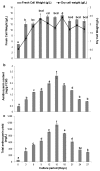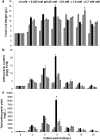Medium composition potentially regulates the anthocyanin production from suspension culture of Daucus carota
- PMID: 29479510
- PMCID: PMC5814386
- DOI: 10.1007/s13205-018-1146-x
Medium composition potentially regulates the anthocyanin production from suspension culture of Daucus carota
Abstract
In the present study, an effort has been made to optimize various culture conditions for enhanced production of anthocyanin. Nutrient content of MS medium (ammonium to potassium nitrate ratio and phosphate concentration) had a profound influence on the cell biomass and anthocyanin accumulation in cell suspension cultures of Daucus carota. Suspension cultures were carried out in shake flasks for 18 days and examined for cell growth, anthocyanin synthesis, anthocyanin yield and development of pigmented cells in relation to the uptake of total sugar, extracellular phosphate, nitrate and ammonia. The addition of NH4NO3 to KNO3 ratio (20.0 mM: 37.6 mM) in the suspension culture media resulted in a 2.85-fold increase in anthocyanin content at day 3. Similarly, a lower concentration of KH2PO4 (0.45 mM) in the MS medium resulted in 1.63-fold increase in anthocyanin content at day 9. The total sugar uptake was closely associated with a significant increase in anthocyanin accumulation. Total sugar and nitrate were consumed until 9-12 days, while ammonia and phosphate were completely consumed within 3 days after inoculation. After 9 days, cell lysis was observed and resulted in the leakage of intracellular substances. These observations suggest that anthocyanin was synthesized only by viable pigmented cells and degraded rapidly after cell death and lysis. This study signifies the utility of D. carota suspension culture for further up-scaling studies of anthocyanin.
Keywords: Ammonium nitrate; Anthocyanin; Nutrient; Phosphate; Potassium nitrate; Suspension culture.
Conflict of interest statement
Compliance with ethical standardsThe authors declare that there is no conflict of interest.
Figures







Similar articles
-
Salt Stress-Induced Anthocyanin Biosynthesis Genes and MATE Transporter Involved in Anthocyanin Accumulation in Daucus carota Cell Culture.ACS Omega. 2021 Sep 15;6(38):24502-24514. doi: 10.1021/acsomega.1c02941. eCollection 2021 Sep 28. ACS Omega. 2021. PMID: 34604632 Free PMC article.
-
Differential expression of anthocyanin biosynthesis genes in Daucus carota callus culture in response to ammonium and potassium nitrate ratio in the culture medium.3 Biotech. 2018 Oct;8(10):431. doi: 10.1007/s13205-018-1447-0. Epub 2018 Sep 29. 3 Biotech. 2018. PMID: 30306000 Free PMC article.
-
The effect of growth retardants on anthocyanin production in carrot cell suspension cultures.Plant Cell Rep. 1992 Jun;11(5-6):304-9. doi: 10.1007/BF00235087. Plant Cell Rep. 1992. PMID: 24203145
-
Image analysis and in vivo imaging as tools for investigation of productivity dynamics in anthocyanin-producing cell cultures of Daucus carota.New Phytol. 2005 Apr;166(1):339-52. doi: 10.1111/j.1469-8137.2004.01308.x. New Phytol. 2005. PMID: 15760374
-
Growth kinetics of vitis vinifera cell suspension cultures: I. Shake flask cultures.Biotechnol Bioeng. 1995 Jul 20;47(2):131-8. doi: 10.1002/bit.260470203. Biotechnol Bioeng. 1995. PMID: 18623385
Cited by
-
Exploring the potential of Carissa spinarum fruit in RTS beverage: a comprehensive study on preparation and stability.J Food Sci Technol. 2025 Jan;62(1):144-154. doi: 10.1007/s13197-024-06017-w. Epub 2024 Jun 27. J Food Sci Technol. 2025. PMID: 39867611
-
Acylation of Anthocyanins and Their Applications in the Food Industry: Mechanisms and Recent Research Advances.Foods. 2022 Jul 21;11(14):2166. doi: 10.3390/foods11142166. Foods. 2022. PMID: 35885408 Free PMC article. Review.
-
Salt Stress-Induced Anthocyanin Biosynthesis Genes and MATE Transporter Involved in Anthocyanin Accumulation in Daucus carota Cell Culture.ACS Omega. 2021 Sep 15;6(38):24502-24514. doi: 10.1021/acsomega.1c02941. eCollection 2021 Sep 28. ACS Omega. 2021. PMID: 34604632 Free PMC article.
-
Enhanced production of Bacopa saponins by repeated batch strategy in bioreactor.Bioprocess Biosyst Eng. 2022 May;45(5):829-841. doi: 10.1007/s00449-022-02700-4. Epub 2022 Feb 4. Bioprocess Biosyst Eng. 2022. PMID: 35119526
-
Anthocyanin Production from Plant Cell and Organ Cultures In Vitro.Plants (Basel). 2023 Dec 31;13(1):117. doi: 10.3390/plants13010117. Plants (Basel). 2023. PMID: 38202425 Free PMC article. Review.
References
-
- Berlin J, Sieg S, Strack D, et al. Production of betalains by suspension cultures of Chenopodium rubrum L. Plant Cell Tissue Organ Cult. 1986;5:163–174. doi: 10.1007/BF00040126. - DOI
-
- Bongue-Bartelsman M, Phillips DA. Nitrogen stress regulates gene expression of enzymes in the flavonoid biosynthetic pathway of tomato. Plant Physiol Biochem. 1995;33:539–546.
LinkOut - more resources
Full Text Sources
Other Literature Sources

